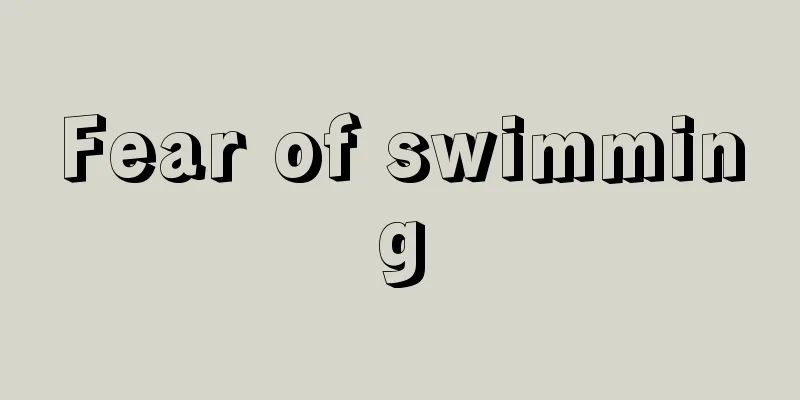Fear of swimming

|
Swimming is a very beneficial way of fitness for the human body. With the construction of some swimming pools in major cities, people are becoming more and more fond of swimming, especially in the hot summer, when the swimming pools are packed with people. Swimming is mainly a sport that takes place in water, but some people are afraid of water and develop swimming phobia. Today we will tell you how to better eliminate swimming phobia. Measures to eliminate fear during swimming: Before preparing to learn swimming, you should first have a full understanding of the characteristics of the human body and water, so that you can reasonably use the conditions of the body, fully master the properties of water, and make use of it. As we all know, the specific gravity of water is 1, while the specific gravity of the human body is approximately between 0.96-1.03. Whether an object sinks or floats in water depends on its specific gravity. Objects with a specific gravity greater than that of water will sink, while objects with a specific gravity less than that of water will float. Knowing these two points, I believe beginners will no longer be afraid of water. When practicing on the water, if you have poor buoyancy or are timid, you can bring a foam back float to increase buoyancy and give beginners a greater sense of security. On the basis of understanding the above knowledge, learn swimming or swimming teaching according to the principle of gradual progress. The main steps are: (I) Walking in water This is the first exercise for beginners after entering the water. The purpose is to experience the resistance, pressure and buoyancy of the water, and to initially learn how to maintain body balance in the water. 1. Hold the edge of the pool or your companion's hand and walk in the water. 2. Hold the edge of the pool or your companion's hand with one hand, and use the other hand to paddle outward and backward in front of your body while walking in the water. 3. Without the help of any support, your arms make symmetrical paddling movements outward and backward in front of your chest, and your feet walk forward, sideways, and backward in the water. 4. Two people stand face to face in chest-deep water, and use one or both hands to splash water on each other's face to experience the feeling of water on the face and head. While becoming familiar with the water, some game-like activities can also be adopted according to the practitioner's mastery of the situation, such as diving, underwater drilling and other exercises. (ii) Learning to Breathe Swimming without breathing cannot be called swimming, it can only be called "holding your breath". The correct way to breathe while swimming is to inhale through your mouth and exhale through your mouth or nose. The steps to learning to breathe are as follows: 1. Stand in shoulder-deep water, hold the edge of the pool with both hands; or hold your companion's hand, open your mouth wide and take a deep breath, bury your head in the water, hold your breath for 10-20 seconds, then raise your head out of the water, exhale, open your mouth wide and take a deep breath, then bury your head in the water... Practice repeatedly. (You can also do the breath-holding exercise while washing your face). 2. Carry out on the basis of 1. After burying your head in the water, do not hold your breath. Instead, exhale slowly through your nose until all the waste gas in your body is exhaled, then quickly raise your head and inhale through your mouth. Practice repeatedly, gradually increasing the frequency of your practice. 3. Be proficient in the above techniques, be able to complete multiple exhalation and inhalation techniques continuously, coherently and naturally, and require yourself to independently complete the slow exhalation and fast inhalation techniques. (III) Floating in water Learning the floating technique in water is mainly to experience the buoyancy of water on the human body, and to initially master the body's ability to balance in water, eliminating the fear of water 1. Floating exercise with knees hugged: Stand on the bottom of the water with both feet, take a deep breath, squat down, lower your head and hug your knees, bring your knees as close to your chest as possible, push the front of your feet off the bottom of the pool, and curl up in a posture with your head down and knees hugged. Try to relax your body and float naturally in the water. When standing, extend your arms forward, press the water down and raise your head. At the same time, straighten your legs and stand with your feet touching the bottom of the pool, with your arms naturally placed at your sides. 2. Floating exercise with stretched body: Stand with your feet apart and your arms relaxed and stretched forward. After taking a deep breath, lean forward and lower your head. Gently push your feet off the bottom of the water and float on the water in a prone position. Spread your arms and legs naturally. Relax your whole body and fully stretch your body. When standing, tighten your abdomen and legs, press the water down with your arms, then raise your head, straighten your legs, and stand with your feet touching the bottom of the pool. 3. Gliding and floating exercises: (1) Edge-pushing and gliding and floating exercises: With your back to the pool, hold the edge of the pool with one hand and extend one arm forward. At the same time, stand on one foot with the other foot close to the pool edge. After taking a deep breath, lower your head and lean your upper body forward in the water into a prone position. Tighten your legs as much as possible, keep your buttocks close to the edge of the pool, and keep the soles of your feet against the edge of the pool. At the same time, the arms that support the edge of the pool are swung forward and brought together with the forearms, with the head clamped between the arms. Then, the feet are pushed out with force to slide forward in a streamlined shape. Requirements: After pushing off the edge of the pool, your body should be fully stretched and try to be relaxed and natural. (2) Push-off gliding and floating exercise: Stand with your feet apart and your arms raised in front of you. After stretching and inhaling, lean your upper body forward. When your head and shoulders are in the water, push the bottom of the pool with the front of your feet. Then bring your feet together and let your body slide forward in a streamlined shape. (IV) Introduction to swimming styles When you first learn to swim, after you become familiar with the water, you should choose a swimming style to learn. Generally speaking, the first stroke to be learned is the breaststroke, followed by the backstroke, crawl and butterfly stroke. This is because although the technical structure of breaststroke is relatively complex and the internal circulation of the movement is highly rhythmic, its breathing is simple, giving beginners a sense of security. Each movement cycle of breaststroke has a clear rest phase, which allows beginners to get enough rest and be mentally prepared for the next movement. Therefore, once you have a basic grasp of its movement structure, you will be able to swim long distances, which is very helpful for getting familiar with water. Once you learn a swimming style, the fear will naturally disappear. 1. Your fear comes from the fear of choking on water, so learning to tread water can help you eliminate your fear. Of course, learning to tread water is more tiring than swimming. You can practice by a deep pool first, and take a rest by the pool when you are exhausted. But be careful not to tread water too hard with your legs when you just learn to tread water, otherwise it is easy to get cramps. Wait until you can hold on for ten seconds and then slowly reduce the number of times you tread water. Gradually, you will tread slower and slower, and you will feel more and more relaxed. When I first learned to tread water, I would get tired after 5 seconds. Now I can tread water for more than 30 minutes without any problem. If you have time, it may also be helpful to watch more videos on treading water online. I have been at your level as well, and I have personal experience. . . 2. It is best not to wear a nose clip, and try to exhale through your nose in the water (do not inhale, otherwise you will choke on water). At the beginning, take a breath, immerse your head in water, and then exhale. You will find that bubbles come out of your nose, which you will find very interesting. When you are out of air, raise your head out of the water and inhale again. You may not be used to it at first, but just practice more and you will be fine. In fact, it is less likely to choke on water when you exhale through your nose than when you use a nose clip, because the air exhaled from your nose will expel the water out of your nose. However, the prerequisite is that your technique must be good enough. I wish you become a swimming expert soon. 1. Reasons for fear of water 1. Choking on water: Being afraid of swimming because of choking on water when holding one’s breath and feeling repulsed by learning to swim. 2. Drowning: The most feared thing about drowning is accidentally falling, and the person cannot swim or is a young child. This experience will remain in the memory for a long time and will cause certain obstacles to swimming teaching. 2. Eliminate fear of water 1. Let those who are learning to swim dare to put their face in the water. 2. Practice method: You can practice holding your breath on land first, and then practice pinching your nose to hold your breath in water. When you can hold your breath in water without pinching your nose for 3 to 5 seconds, that's it. 3. Tips Take a deep breath → pinch your nose → sink down → let go (count silently 1.2.3.) → stand up and blow out the air through your nose (blow out the air through your nose to prevent choking on water). You can also use rhythmic breathing: take a deep breath → sink down → exhale through your nose → exhale to the surface of the water → open your mouth and inhale, or you can exhale through your mouth. |
<<: How to remove the smell from curtains
>>: How to remove the strong smell of denim clothes_How to remove the smell of denim clothes
Recommend
Health care experience of patients with advanced lung cancer
For the treatment of lung cancer, many people sta...
How many years does it take for ovarian cancer to develop? 5 reasons for the high incidence of ovarian cancer
Ovarian cancer is a cancer that occurs in the fem...
Is lymphoma biopsy accurate?
Lymphocytes are the health guardians of the human...
How to treat vitiligo?
Vitiligo is a common skin disease. Patients with ...
Temporomandibular joint pain
Many people do not have much understanding of joi...
At what age can a baby drink milk without a pacifier
When babies are young, they absorb nutrition by d...
10 ways to massage your ears to strengthen your kidneys and keep fit
Each organ and tissue of the human body has a cor...
Can kidney cancer metastasize to the liver be transmitted to others?
Can kidney cancer metastasize to the liver be tra...
What to do if you feel weak after chemotherapy
Chemotherapy is the only method people use to tre...
Method of using blister beetles to treat cattle ringworm
The method of using blister beetles to treat psor...
How to make up for staying up late
Staying up late is actually very harmful to physi...
Is running good for sex life?
I believe everyone is familiar with the sport of ...
What is the secret recipe of traditional Chinese medicine for treating thyroid cancer
What is the secret recipe of TCM for the treatmen...
Does avocado help you lose weight or gain weight?
The nutritional value of avocado is relatively hi...
How to prevent lung cancer better To prevent lung cancer, you need to master these common sense
There are many reasons for lung cancer. For peopl...









